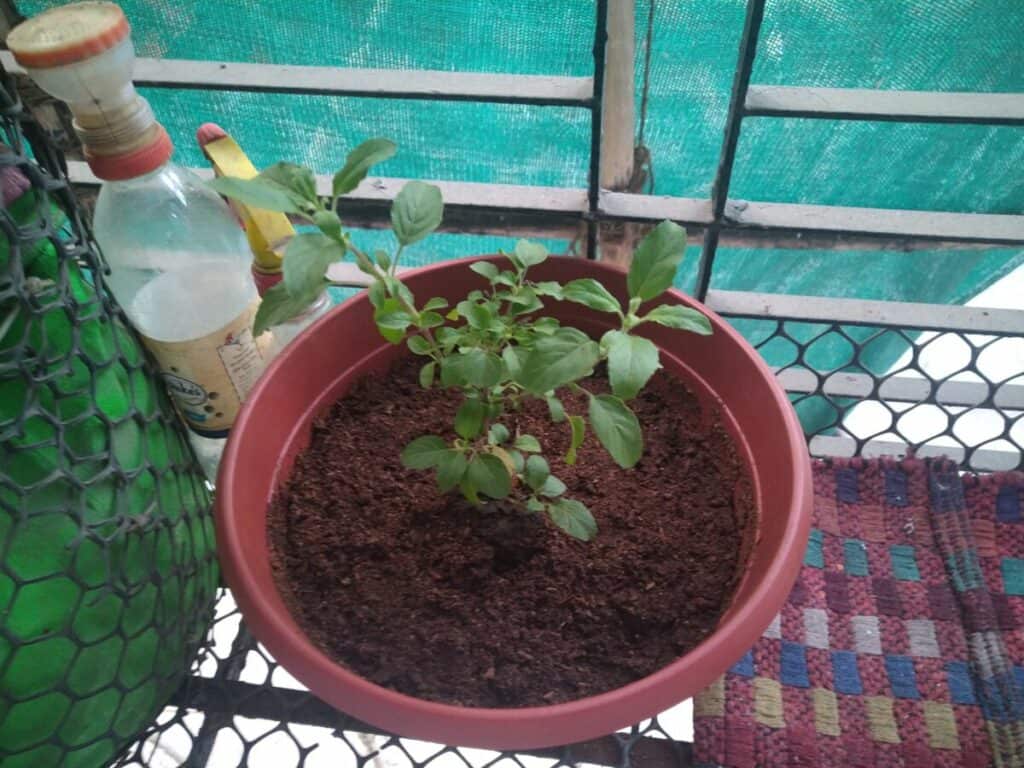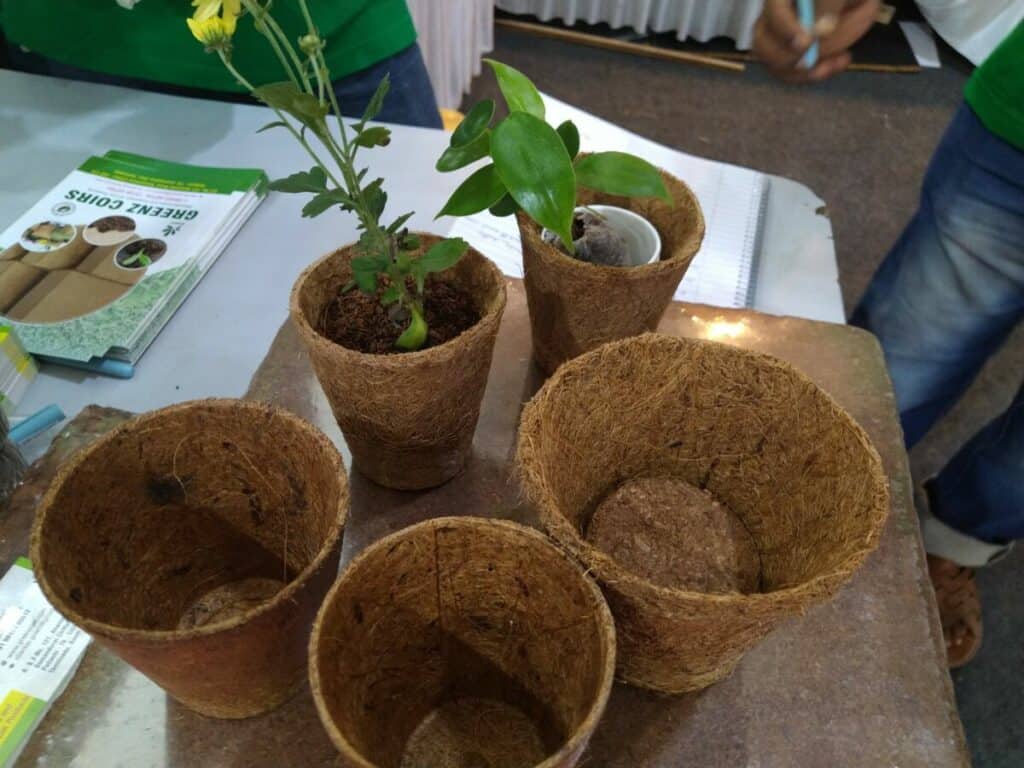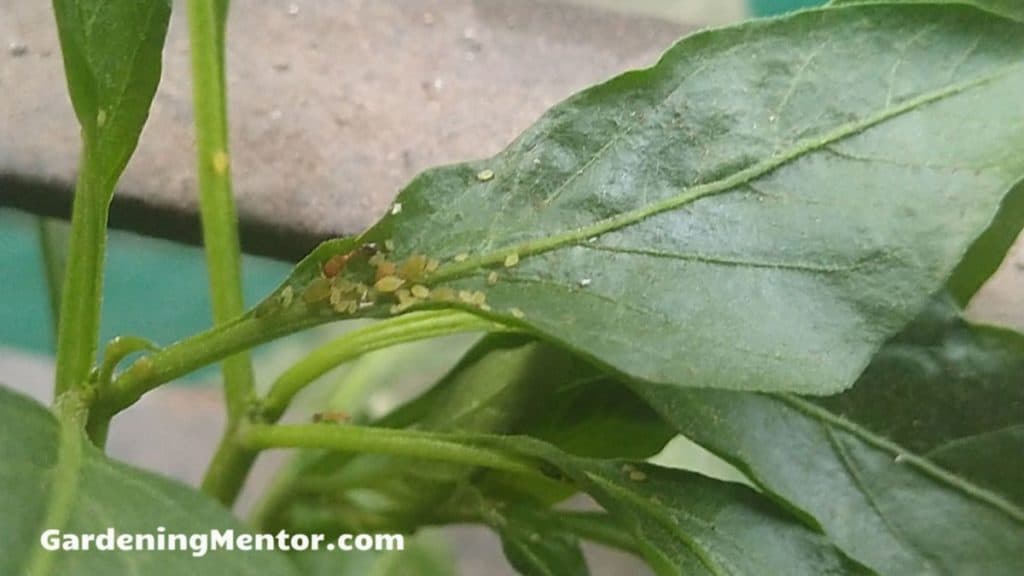Basil is the plant you should grow.
Why?
It’ll help save you a ton of money that you spend buying basil from the store. And you get to eat sweet, fresh basil from your own organic garden.
You can eat it fresh from the harvest or dry and preserve it for adding flavor to your food.
And the good thing is that it’s quite easy to grow and hard to mess up. All you need is a little help to learn about basil and get you started.
What is basil?
The basil plant, Ocimum basilicum, is a member of the mint family and native to Africa and parts of Southeast Asia. It’s grown mostly as an annual in temperate climates, but some varieties are considered perennial if given the right growing environments.
Historically, basil was used in both cooking and medicine, and it’s a part of many culinary traditions around the world. Today, thanks to the breeding efforts of basil growers, there are many different varieties of basil that can be easily cultivated in a wide range of environments.
The available varieties differ not only in size, shape, and sometimes color but also in taste. Lemon basil, for example, has a bright note of lemon that can easily be detected by smell when a leaf is crushed.
What are some basil plant varieties?
Some popular basil varieties include:
Sweet Basil: Sometimes called “Genovese Basil,” this variety is typically what we think of when we hear the word “basil.” It’s got large, deep green leaves that bruise easily and are very fragrant when cut. Sweet basil grows well in a variety of environments.
Thai Basil: This subtype of basil also comes in several varieties, but in general the flavor is spicier than that of sweet basil, and, as the name implies, it is commonly used in Indonesian cuisines. The leaves of Thai basil are narrower and more pointed than those of sweet basil, and the stems typically purple instead of green.
French Basil: This variety of basil, also known as Marseilles Basil, is a compact dwarf variety that’s well suited to small gardens. Its leaves are a bit smaller, but it produces well and is renowned for its flavor.
Purple Basil: With striking, bronze-purple leaves, this basil variety is grown for its visual appeal as much as for its flavor. You can tuck it into flower planters right outside the kitchen door for a beautiful, fragrant addition to the container as well as a convenient source of sweet, peppery fresh basil.
African Blue Basil: This hybrid is often grown as a perennial because it is tolerant of cooler climes, though it’s considered tender and will need a lot of protection to survive harsh northern winters.
It’s a cross between a variety of sweet basil called “Dark Opal” and a camphor-scented African basil variety. The taste is quite strong, and a bit different from your average sweet basil—the camphor-y notes of the parent plant definitely come through—but if you’ve got a cooler climate or don’t get quite enough sun for Genovese basil, African Blue might be the plant to try.
You’ll have to grow it from cuttings, however; being a hybrid, it’s not capable of generating seeds that can germinate and grow new plants.
Cinnamon Basil: This is one of many unique “flavored” basil plants, which range from lemon, lime, and orange to pineapple, chocolate, and licorice. The flavors come from the different oils the plants produce, like citral and limonene in lemon basil.
Most basil varieties produce some level of these different flavorful compounds, but selective breeding has resulted in varieties that pack an intensely flavored punch, like the spice of cinnamon.

How to choose a planting site for basil?
Basil plants aren’t terribly picky, but if you want them to provide a bountiful harvest, they’ll need plenty of sunlight, rich but well-drained soil, and warm temperatures.
Growing in the garden
Look for a spot that gets between six and eight hours of sun each day. Ideally, you want it to be slightly sheltered to protect it from cold snaps at the beginning and end of the season. Tucked beside the house in a sunny herb bed is a perfect location.
Basil also works well as a companion plant in the garden. The strong smell keeps some pests away, and it’s a great partner for plants like tomatoes and peppers.
Growing in a planter
Basil can get quite large, so choose a sizeable pot with drainage holes. A deep pot is best to accommodate the plant’s long taproots.
Use a rich potting soil blended with compost, but make sure not to block the pot’s drainage holes, as basil is prone to root rot if left too wet. Once you’ve planted your basil, move the pot to a warm, sunny location outdoors and make sure to water regularly.
When should you plant basil?
Because basil is a tropical or semi-tropical plant, it will not do well if you allow it to be exposed to cold temperatures or frost.
If you plan to plant your basil indoors, you can do so anytime. Just make sure the planter receives plenty of light and isn’t too close to cold windows during the winter. Basil won’t thrive as a houseplant the way it will in the garden, but in mid-winter, even a bit of fresh basil is better than none at all!
If you’re planning on planting outdoors, you’ll have to wait until after the risk of frost has passed. You can sow directly into the garden at this point, but for a quicker harvest, it’s better to start seeds indoors or buy transplants from a garden center to plant directly into your garden.
How to plant basil in the garden?
Basil is quite easy to plant, and there are several ways to go about it.
Growing from seeds
To start your own seedlings, plant them in germination-promoting potting mix six weeks ahead of the last frost date for your area. Small, biodegradable peat pots make this easy and relatively mess-free. Use three to five seeds per pot depending on how old your seeds are (the newer the seeds, the better the germination rate will be), and plant them about ¼ inch deep.

Basil seeds need plenty of light and warmth to grow well, so a heated germination mat and additional lighting will serve well. Mist regularly to keep the soil damp, but not so wet that water pools or mold begins to form. Cover the plants with a tabletop greenhouse (plastic food wrap will do in a pinch) to help keep in the warmth and increase the humidity.
Once your seeds have sprouted, wait until they’ve developed their first real leaves, then pinch back the smaller seedlings in any pots where more than one germinated. Keep the seedlings watered and warm until they’re ready to go outside.
Growing from transplants
When you’re ready to plant basil in the garden, make sure the risk of frost has passed. Basil does not deal well with cool temperatures and will fare best when evening temperatures don’t drop below 50° F.
Prepare your soil with a blend of compost or additives like fish or bone meal. Basil needs lots of nutrients to produce a good harvest, and it likes rich but well-drained soil.
Plant your basil seedlings 12-18 inches apart. Airflow is crucial because basil is prone to fungal infections if left too wet. The larger, broad-leafed varieties will need more room than small, bushy types. Be sure to read up on the growth habits of your particular varieties before planting.
Growing from cuttings
Basil also grows well from cuttings, which can be a fun family project. Cut a stem about four inches long from a healthy basil plant that hasn’t yet bloomed. Clip off the lower leaves, if necessary, and submerge the stem in water.
Keep this cutting in a warm, bright location, and freshen up the water as necessary. You should start to see roots emerging along the stem where the leaves join it. Within a few weeks, your cutting should be ready to plant just like a regular seedling.
How to take care of your basil plants?
One of the best things about basil is that it’s relatively low maintenance. It likes to be well-watered, so check regularly and top off the planter if the soil an inch below the surface feels dry.
For garden-grown basil, most can handle daily watering unless your soil is heavy or your climate particularly wet.
Though you can grow basil just for its appearance and blooms, most of the time, you’re hoping for a hearty harvest of leaves. To encourage that, regular harvesting is crucial. Get the full details below.
How to harvest and store basil?
Basil can be harvested as soon as it’s got six to eight leaves. Rather than plucking just the leaves, you want to clip the stems back to encourage branching and more leaf growth. Once there are six to eight leaves on a plant, clip back the stems to the second set of leaves (leaving four leaves on the plant).
The plant will then form new branches and you can repeat this process each time a branch has six to eight new leaves. These secondary branches can be cut back to the first set of leaves, as those elsewhere on the plant will help support growth overall.
Once a basil plant begins to flower, the stems grow woody and the leaves more bitter in taste. You can prevent this, and encourage a bountiful harvest, by keeping up with regular harvesting and removing any stems that begin to set blossoms as soon as you notice them.
Storage Techniques
It only takes a few plants before you’ve got more basil than you know what to do with! Here are a few ideas for making that garden-fresh flavor lasts as long as possible.
Fresh: Obviously, fresh is the most flavorful way to enjoy basil. Store freshly cut stems in a glass of water in a cool place out of direct sunlight.
Frozen: When fresh isn’t an option, frozen is the next best way to preserve as much of the delicate flavor as possible. Strip leaves off stems and then use a strainer to dip them quickly in boiling water for a quick blanching. This preserves the color. You can then layer them on a paper towel and freeze them whole.
Alternatively, use a food processor to grind leaves into a paste (add a little olive oil if the mix is too thick) and freeze in ice cube trays. Store in zip-top freezer bags to keep them from absorbing freezer smells.
Dried: Dried basil doesn’t have the same brightness as fresh, but homemade dried basil is still more flavorful than anything you’ll find at the store. There are lots of methods for drying homegrown herbs but the most basic is to use a rubber band to loop together a small bunch of basil, then hang it upside down to dry.
Extracts: The flavorful oils in basil can also be used to impart that taste to condiments like olive oil or vinegar. Use clean, dried leaves, lightly bruised, and allow them to soak in oil or vinegar for several days to several weeks, depending on the depth of flavor and herbs you’re using.
What are pests and diseases that affect basil plants?
It’s not tough to grow basil, but occasionally things do go wrong. Here’s what to do if you run into problems.
Pests
The strong scent of basil keeps many pests away, but there are still a few that can cause problems, namely:
Slugs: These slimy little critters leave bleached out trails on your plants leaves as they scrape away and eat the leaf material. Since you don’t want to cover your edible herbs with pesticides, opt for more environmentally friendly deterrents.
One such option is diatomaceous earth (DE), which is made from the microscopic silica skeletons of sea creatures. These pointy little silica shards cut through the insects’ protective outer layer and cause them to desiccate and die. DE is completely harmless to people, pets, and any insects that don’t touch it directly. This makes it perfect for targeting slugs and avoiding pollinators.
A thin layer of DE around the base of your plants, refreshed after it rains, will keep slugs at bay.
Aphids: These annoying little nibblers arrive en masse and can cause an otherwise healthy plant to wither as they suck out water and nutrients through the stems and leaves. Aphids are tough to handle without using some kind of spray because they’re so tiny and numerous, but insecticidal soap is a good option.

Make sure to cut away any blooms on the plant, because this pesticide will harm pollinators if they come in contact with it. Avoid spraying plants you plan to harvest soon, and always wash any plants that may have come in contact with pesticides, even mild ones.
Japanese Beetles: These pests aren’t picky when it comes to which leaves they eat. In fact, they’ll eat them all! The best way to manage Japanese beetles is by hand-picking.
It may be icky, but donning a pair of gloves, removing, and crushing the beetles is safer for pollinators and won’t leave pesticide residues on your plants.
Diseases
Basil is most prone to fungal diseases, which can be tough to treat. Watch out for:
Fusarium Wilt: A soil-borne disease, fusarium wilt is very hard to effectively treat. It causes stunted, poor growth, followed by leaf yellowing and dropped leaves. The symptoms can resemble other issues, like too little water, so be vigilant! Remove any affected plants and treat any remaining with fungicide.
Grey Mold & Downy Mildew: These diseases are often mistaken for one another as both cause a film of downy grey mold on the surface of the plant’s leaves and stems.
Again, it’s tough to treat, so prevention is your best bet. Water at soil level to avoid standing water on leaves and make sure there’s adequate space between plants for good airflow.
Environmental Factors
Basil may not be too picky in most respects, but there are two factors about which it is very particular indeed.
Cold: Frost will cause the basil to blacken, wilt, and die, all in about a day. There’s no saving basil that’s been hit by a frost, so make sure to avoid planting too early in the spring, and harvest before the frosts come in fall.
If an unseasonal cold does strike, cover your plants in the evening with sheets or a tarp. Make sure to use stakes to hold the material up so it can trap warm air beneath it, and to avoid crushing your plants.
Water: Basil likes to be wet, but not too wet. Basil that doesn’t receive enough water will be small and stunted and will try to set flowers early in the growing season.
Basil that’s too wet will be prone to fungal diseases. It may show discolored leaves, wilt, and then die. Too much water is tough to recover from, so make sure the site or pot you choose for your basil drains well. It’s always easier to add water than to try and take it away!
Summary
In many ways, basil is an ideal herb for beginning gardeners. It will do well just about anywhere and has few pests and diseases to cause problems.
The best way to get started is to stop by a local plant nursery and pick up a few seedlings. Try them out in a few locations and see what works best. Water well, and watch them grow!

Fact Checked, Written, and Published by Kevin Rodrigues
Kevin is the founder of Gardening Mentor, a website that aims to teach people to grow their own food in a limited space. As a self-taught gardener, Kevin has spent several years growing plants and creating gardening content on the website. He is certified in Home Horticulture and Organic Gardening from Oregon State University. He has a Post Graduate Diploma in Horticulture and Landscape Gardening from Mumbai University.
Read more
